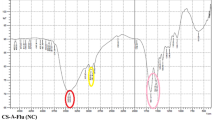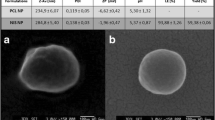Abstract
Farnesol is a natural essential oil with antimicrobial properties. Complexation of farnesol in chitosan nanoparticles can be useful to improve its bioavailability and potentiate its antifungal capabilities such as inhibition of hyphal and biofilm formation. The aim of this study was to develop and characterize chitosan nanoparticles with farnesol (NF) and evaluate their toxicity and antifungal action on C. albicans in vivo. The NF were prepared by the ionic gelation method and showed physicochemical characteristics such as diameter less than 200 nm, monodisperse distribution, positive zeta potential, spherical morphology, and stability after 120 days of storage. In the evaluation of toxicity in Galleria mellonella, NF did not reduce the survival rate, indicating that there was no toxicity in vivo at the doses tested. In the assays with G. mellonella infected by C. albicans, the larvae treated with NF had a high survival rate after 48 h, with a significant reduction of the fungal load and inhibition of the formation of biofilms and hyphae. In the murine model of vulvovaginal candidiasis (VVC), histopathological analysis showed a reduction in inflammatory parameters, fungal burden, and hyphal inhibition in mice treated with NF. The produced nanoparticles can be a promising alternative to inhibit C. albicans infection.











Similar content being viewed by others
Data availability
All data generated or analyzed during this study are included in this published article. The authors alone are responsible for the content and the writing of the paper.
References
Ramage G, Saville SP, Wickes BL, López-Ribot JL (2002) Inhibition of Candida albicans biofilm formation by farnesol, a quorum-sensing molecule. Appl Environ Microbiol 68(11):5459–5463. https://doi.org/10.1128/AEM.68.11.5459-5463.2002
Patra JK, Das G, Fraceto LF et al (2018) Nano based drug delivery systems: recent developments and future prospects. J Nanobiotechnology 16(1):71. https://doi.org/10.1186/s12951-018-0392-8
Arya N, Chakraborty S, Dube N, Katti DS (2009) Electrospraying: a facile technique for synthesis of chitosan-based micro/nanospheres for drug delivery applications. J Biomed Mater Res B Appl Biomater 88(1):17–31. https://doi.org/10.1002/jbm.b.31085
Fernandes Costa A, Evangelista Araujo D, Santos Cabral M et al (2019) Development, characterization, and in vitro-in vivo evaluation of polymeric nanoparticles containing miconazole and farnesol for treatment of vulvovaginal candidiasis. Med Mycol 57(1):52–62. https://doi.org/10.1093/mmy/myx155
Dhawan S, Singla AK, Sinha VR (2004) Evaluation of mucoadhesive properties of chitosan microspheres prepared by different methods. AAPS PharmSciTech 5(4):e67. Published 2004 Jul 26. https://doi.org/10.1208/pt050467
Agnihotri SA, Mallikarjuna NN, Aminabhavi TM (2004) Recent advances on chitosan-based micro- and nanoparticles in drug delivery. J Control Release 100(1):5–28. https://doi.org/10.1016/j.jconrel.2004.08.010
Nikoomanesh F, Roudbarmohammadi S, Khoobi M, Haghighi F, Roudbary M (2019) Design and synthesis of mucoadhesive nanogel containing farnesol: investigation of the effect on HWP1, SAP6 and Rim101 genes expression of Candida albicans in vitro. Artif Cells Nanomed Biotechnol 47(1):64–72. https://doi.org/10.1080/21691401.2018.1543193
Clark RE, Squire LR (2010) An animal model of recognition memory and medial temporal lobe amnesia: history and current issues. Neuropsychologia 48(8):2234–2244. https://doi.org/10.1016/j.neuropsychologia.2010.02.004
Mikulak E, Gliniewicz A, Przygodzka M, Solecka J (2018) Galleria mellonella L. as model organism used in biomedical and other studies. Przegl Epidemiol 72(1):57–73
Champion OL, Wagley S, Titball RW (2016) Galleria mellonella as a model host for microbiological and toxin research. Virulence 7(7):840–845. https://doi.org/10.1080/21505594.2016.1203486
Jemel S, Guillot J, Kallel K, Botterel F, Dannaoui E (2020) Galleria mellonella for the evaluation of antifungal efficacy against medically important fungi, a narrative review. Microorganisms 8(3):390. https://doi.org/10.3390/microorganisms8030390
Allegra E, Titball RW, Carter J, Champion OL (2018) Galleria mellonella larvae allow the discrimination of toxic and non-toxic chemicals. Chemosphere 198:469–472. https://doi.org/10.1016/j.chemosphere.2018.01.175
Calvo P, Remunán-López C, Vila-Jato JL (1997) Novel hydrophilic chitosan polyethylene oxide nanoparticles as protein carriers. J Appl Polym Sci 63:125–132
Costa AF, Silva LDC, Amaral AC (2021) Farnesol: An approach on biofilms and nanotechnology. Med Mycol 59(10):958–969. https://doi.org/10.1093/mmy/myab020
Bilia AR, Guccione C, Isacchi B, Righeschi C, Firenzuoli F, Bergonzi MC (2014) Essential oils loaded in nanosystems: a developing strategy for a successful therapeutic approach [retracted in: Evid Based Complement Alternat Med. 2021 Feb 15;2021:7259208]. Evid Based Complement Alternat Med 2014:651593. https://doi.org/10.1155/2014/651593
Abd El-Hack ME, El-Saadony MT, Shafi ME et al (2020) Antimicrobial and antioxidant properties of chitosan and its derivatives and their applications: a review. Int J Biol Macromol 164:2726–2744. https://doi.org/10.1016/j.ijbiomac.2020.08.153
Lai SK, Wang YY, Hida K, Cone R, Hanes J (2011) Nanoparticles reveal that human cervicovaginal mucus is riddled with pores larger than viruses [published correction appears in Proc Natl Acad Sci U S A 108(34):14371]. Proc Natl Acad Sci U S A 107(2):598-603.https://doi.org/10.1073/pnas.0911748107
Vaghasiya K, Sharma A, Ray E, Adlakha S, Verma RK (2020) Methods to characterize nanoparticles for mucosal drug delivery. In: Muttil P., Kunda N. (eds) Mucosal delivery of drugs and biologics in nanoparticles. AAPS Advances in the Pharmaceutical Sciences Series 41:27-57
Danaei M, Dehghankhold M, Ataei S, et al (2018) Impact of particle size and polydispersity index on the clinical applications of lipidic nanocarrier systems. Pharmaceutics 10(2):57. Published 2018 May 18. https://doi.org/10.3390/pharmaceutics10020057
Freitas C, Muller RH (1998) Effect of light and temperature on zeta potential and physical stability in solid lipid nanoparticle (SLN (TM)) dispersions. Int J Pharm 168(2):221–229. https://doi.org/10.1016/S0378-5173(98)00092-1
Islam MA, Park TE, Reesor E et al (2015) Mucoadhesive chitosan derivatives as novel drug carriers. Curr Pharm Des 21(29):4285–4309. https://doi.org/10.2174/1381612821666150901103819
Woranuch S, Yoksan R (2013) Eugenol-loaded chitosan nanoparticles: I Thermal stability improvement of eugenol through encapsulation. Carbohydr Polym 96(2):578–585. https://doi.org/10.1016/j.carbpol.2012.08.117
Du J, Wang S, You H, Zhao X (2013) Understanding the toxicity of carbon nanotubes in the environment is crucial to the control of nanomaterials in producing and processing and the assessment of health risk for human: a review. Environ Toxicol Pharmacol 36(2):451–462. https://doi.org/10.1016/j.etap.2013.05.007
National Center for Biotechnology Information (2022) PubChem Database. Farnesol, CID=3327. https://pubchem.ncbi.nlm.nih.gov/compound/Farnesol (accessed 15 May 2022).
Černáková L, Jordao L, Bujdáková H (2018) Impact of farnesol and Corsodyl® on Candida albicans forming dual biofilm with Streptococcus mutans. Oral Dis 24(6):1126–1131. https://doi.org/10.1111/odi.12873
Arias LS, Butcher MC, Short B, et al (2020) Chitosan ameliorates Candida auris virulence in a Galleria mellonella infection model [published correction appears in Antimicrob Agents Chemother. 2021 Feb 17;65(3):]. Antimicrob Agents Chemother 2020;64(8):e00476-20. https://doi.org/10.1128/AAC.00476-20
Cé R, Silva RC, Trentin DS et al (2020) Galleria mellonella larvae as an In Vivo model to evaluate the toxicity of polymeric nanocapsules. J Nanosci Nanotechnol 20(3):1486–1494. https://doi.org/10.1166/jnn.2020.17170
Pierce CG, Srinivasan A, Ramasubramanian AK, López-Ribot JL (2015) From biology to drug development: new approaches to combat the threat of fungal biofilms. Microbiol Spectr 3(3):https://doi.org/10.1128/microbiolspec.MB-0007-2014
Hornby JM, Jensen EC, Lisec AD et al (2001) Quorum sensing in the dimorphic fungus Candida albicans is mediated by farnesol. Appl Environ Microbiol 67(7):2982–2992. https://doi.org/10.1128/AEM.67.7.2982-2992.2001
Vila T, Romo JA, Pierce CG, McHardy SF, Saville SP, Lopez-Ribot JL (2017) Targeting Candida albicans filamentation for antifungal drug development. Virulence 8(2):150–158. https://doi.org/10.1080/21505594.2016.1197444
Samaranayake YH, Samaranayake LP (2001) Experimental oral candidiasis in animal models. Clin Microbiol Rev 14(2):398–429. https://doi.org/10.1128/CMR.14.2.398-429.2001
Singkum P, Muangkaew W, Suwanmanee S, Pumeesat P, Wongsuk T, Luplertlop N (2020) Suppression of the pathogenicity of Candida albicans by the quorum-sensing molecules farnesol and tryptophol. J Gen Appl Microbiol 65(6):277–283. https://doi.org/10.2323/jgam.2018.12.002
Xie Z, Thompson A, Kashleva H, Dongari-Bagtzoglou A (2011) A quantitative real-time RT-PCR assay for mature C albicans biofilms. BMC Microbiol 11:93. https://doi.org/10.1186/1471-2180-11-93
Hisajima T, Maruyama N, Tanabe Y et al (2008) Protective effects of farnesol against oral candidiasis in mice. Microbiol Immunol 52(7):327–333. https://doi.org/10.1111/j.1348-0421.2008.00044.x
Naglik JR, Fidel PL Jr, Odds FC (2008) Animal models of mucosal Candida infection. FEMS Microbiol Lett 283(2):129–139. https://doi.org/10.1111/j.1574-6968.2008.01160.x
Yano J, Fidel PL Jr (2011) Protocols for vaginal inoculation and sample collection in the experimental mouse model of Candida vaginitis. J Vis Exp 58:3382. https://doi.org/10.3791/3382
Funding
This work was supported by the Federal University of Goiás (UFG) and the Research Support Foundation of the State of Goiás (FAPEG).
Author information
Authors and Affiliations
Corresponding author
Ethics declarations
Competing interests
The authors declare no competing interest.
Additional information
Responsible Editor: Celia Maria de Almeida Soares
Publisher's Note
Springer Nature remains neutral with regard to jurisdictional claims in published maps and institutional affiliations.
Rights and permissions
Springer Nature or its licensor (e.g. a society or other partner) holds exclusive rights to this article under a publishing agreement with the author(s) or other rightsholder(s); author self-archiving of the accepted manuscript version of this article is solely governed by the terms of such publishing agreement and applicable law.
About this article
Cite this article
Costa, A.F., da Silva, J.T., Martins, J.A. et al. Chitosan nanoparticles encapsulating farnesol evaluated in vivo against Candida albicans. Braz J Microbiol 55, 143–154 (2024). https://doi.org/10.1007/s42770-023-01168-y
Received:
Accepted:
Published:
Issue Date:
DOI: https://doi.org/10.1007/s42770-023-01168-y




